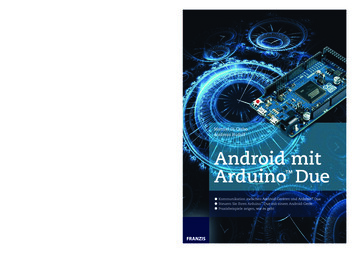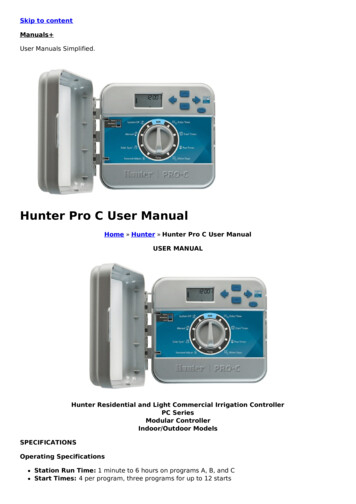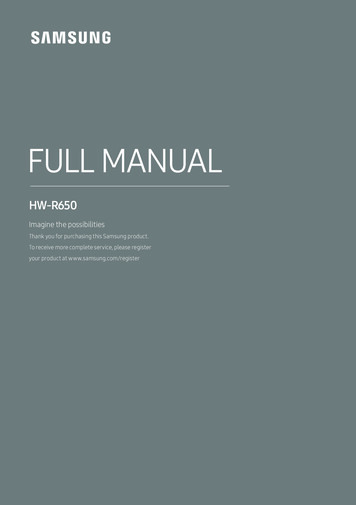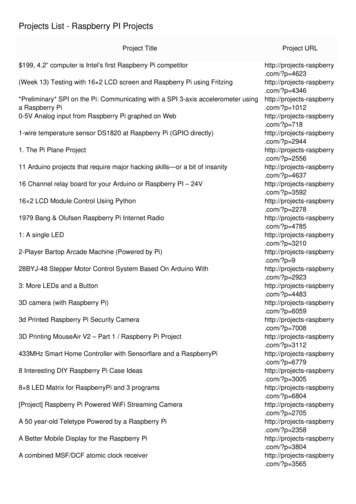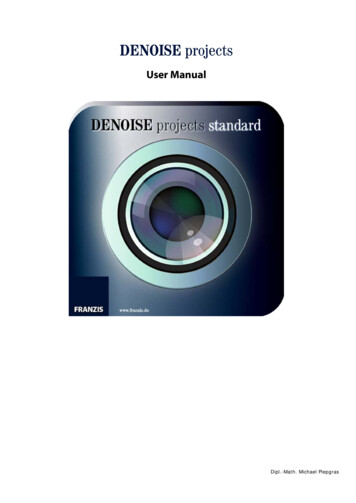
Transcription
DENOISE projectsUser ManualDipl.-Math. Michael Piepgras
Contents1. Installation and Registration .31.1 Installation on Windows .31.2 Installation on Mac .41.3 Installation of Adobe Photoshop Plug-ins .41.4 Registration . 192. Image Noise - what is it? . 203. DENOISE projects – The Start Screen . 214. The Work Area . 224.1 Tool List . 224.2 Presets . 254.3 Denoise Section (Noise Properties) . 264.4 Expert Mode . 335. Keyboard and Mouse Shortcuts . 39Support . 402
1. Installation and Registration1.1 Installation on WindowsThe start screen for the installation will normally be automatically displayed. If the autostart function of your CD/ DVD drive is deactivated, open the start screen manually bygoing to My Computer, double clicking on the CD/DVD drive symbol and thenStarter.exe or Starter.Once you are at the CD start screen, choose your language and then click on InstallDENOISE projects.Choose German, English or French as setup language and follow the installationassistant’s instructions.3
1.2 Installation on MacLoad your CD into your CD/DVD drive and open the installation menu through thedesktop. Drag the DENOISE projects professional file into the program link. To usethe Adobe Photoshop plug-ins, open the Adobe Photoshop plug-ins folder and copythe appropriate plug-ins into your Photoshop plug-ins folder. You can now use DENOISEprojects professional to edit your photos!1.3 Installation of Adobe Photoshop Plug-insDuring the installation, you will be asked if you would like to install the Adobe Photoshop plug-in.If you agree to this, you can use DENOISE projects as a plug-in for Adobe Photoshop.Alternatively, the plug-ins can also be manually copied into the Adobe Photoshop plugin folder. Select the plug-in entry folder in the CD start menu to open it.Additionally, the latest plug-ins for your software are available at:http://www.projects-software.com/plugins4
1.3.1 Windows 32 Bit Operating Systems1. Complete the installation of DENOISE projects by activating the software.2. For some reasons it may occur that plug-ins cannot be installed automatically in allAdobe Photoshop versions. They have to be copied into the plug-ins folder ofAdobe Photoshop manually.3. Please close Adobe Photoshop as well as the stand-alone version of DENOISEprojects.4. Open the installation package folder of DENOISE projects. Here, you will find theplug-ins for all versions of Adobe applications that are supported.5. Open the plug-in folder of your Adobe application (in this instruction the installationof the plug-in will be demonstrated for Adobe Photoshop CS6).6. Copy the file DENOISEProjectsStandard PH6 x86.8be from installationpackage and paste it into the plug-ins folder of Adobe Photoshop CS6 that you willfind here:C:\Program Files\Adobe\Adobe Photoshop CS6\Plug-ins5
7. Restart your Photoshop application and open an image.8. Navigate to File Export DENOISE projects standard .One click will start the plug-in. The image will now be opened in DENOISEprojects.The plug-in will not be in the Filter menu.6
7
1.3.2 Windows 64 Bit Operating Systems1. Complete the installation of DENOISE projects by activating the software.2. For some reasons it may occur that plug-ins cannot be installed automatically in allAdobe Photoshop versions. They have to be copied into the plug-ins folder ofAdobe Photoshop manually.3. Please close Adobe Photoshop as well as the stand-alone version of DENOISEprojects.4. Open the installation package folder of DENOISE projects. Here, you will find theplug-ins for all versions of Adobe applications that are supported.5. Open the plug-in folder of your Adobe application (in this instruction the installationof the plug-in will be demonstrated for Adobe Photoshop CC 2015).6. Copy the file DENOISEProjectsStandard PH7 x64.8be from the installationpackage and paste it into the plug-ins folder of Adobe Photoshop CC 2015 thatyou will find here:C:\Program Files\Adobe\Adobe Photoshop CC 2015\Plug-ins8
7. Restart your Photoshop application and open an image.8. Navigate to File Export DENOISE projects standard .One click will start the plug-in. The image will now be opened in DENOISEprojects.The plug-in will not be in the Filter menu.9
10
1.3.3 MAC OS X Operating Systems1. Complete the installation of DENOISE projects by activating the software.2. Open the installation package folder of DENOISE projects. Here, you will find theplug-ins for all versions of Adobe applications that are supported.3. Please close Adobe Photoshop as well as the stand-alone version of DENOISEprojects.4. Additionally, the latest plug-ins for your software are available at:http://www.projects-software.com/plugins5. Open the plug-in folder of your Adobe application (in this instruction the installationof the plug-in will be demonstrated for Adobe Photoshop CC 2015).11
6. Copy the file DENOISEProjectsStandard PH7.plugin from the installationpackage and paste it into the plug-ins folder of Adobe Photoshop CC 2015 thatyou will find here:Applications/Adobe Photoshop CC 2015/plug-ins7. Restart your Photoshop application and open an image8. Navigate to File Export DENOISE projects standard . One click will startthe plug-in. The image will now be opened in DENOISE projects.You won’t find it as another filter.12
13
1.3.4 Adobe Lightroom Interface with DENOISE projectsWindows Operating Systems1. Open Adobe Lightroom.2. Open Edit/Preferences/External Editing/Additional External Editor.3. In Additional External Editor choose the application DENOISE projectsstandard.exe4. Click OK.14
5. Right-click on a picture in Adobe Lightroom.6. Choose Edit In Edit in DENOISE projects standard.exe 7. If you still cannot find DENOISE projects in the Edit In list please check if theDENOISE projects application is definitely set as external editor and restartAdobe Lightroom.15
MAC OS X1. Open your Adobe Lightroom Application.2. Open Preferences/External Editing.3. Navigate to section Additional External Editor in the middle of the window.There is no application specified as default setting.4. Click on Choose in order to open the application folder of your MAC and to setyour external editor.16
5. Navigate to the DENOISE projects standard application and click once tohighlight it. Confirm with Choose.6. DENOISE projects standard has been set as external application now.7. Close that window and restart Adobe Lightroom.17
8. Open an image from your Adobe Lightroom catalogue. Click on the picture whileholding down the CTRL key.9. Choose Edit In Edit in DENOISE projects standard and your photo willbe opened in DENOISE projects.It will not be saved here: You can edit your image with DENOISE projects andthen go back to Adobe Lightroom for more adjustments without wasting toomuch disc space. When you finished editing your picture you have to save thedeveloped photo only one time.If you still cannot find DENOISE projects standard in the Edit In list pleasecheck if the DENOISE projects application is definitely set as external editor inthe Preferences menu of Adobe Lightroom.18
1.4 RegistrationUpon opening DENOISE projects for the first time you will be requested to register theprogram. Proceed according to the following:1. Install DENOISE projects as described.2. Input the serial number. For the box version, this can be found in the accompanyingbooklet. If you have the downloadable version, the serial number will have been sent toyou by email directly after the purchase.3. Finally, click on the “Activate now” button. The software has now been successfullyactivated.Note: Using the same serial number, DENOISE projects can be installed on up totwo computers.A second serial number is not necessary. For an additional installation on a differentcomputer, enter the serial number and then click on “Activate now”.19
2. Image Noise - what is it?Image noise in digital image production occurs in many different ways.One example is so-called low noise, a sensor-dependent noise caused by CDD and CMOSsensors. An additional multiplier is the reading strength in digital cameras, whichproduces read noise.Hot pixels can appear with increased age of the camera or through image sensormanufacturing defects. These are individual pixel sensors that were incorrectlymanufactured or have a significantly higher light sensitivity compared to the pixelsaround them.It generally the case, that the higher the ISO Number (the camera’s exposure setting) is,the more visible the noise will be.What types of image noise can you reduce or remove with DENOISE projects?- Chroma Noise (colour noise)(Filter: Denoising - colour)-Luminance Noise (bright noise)(Filter: Denoising - HD)-Hot pixels(Filter: Hotpixel noise suppression)-Salt & Pepper (individual defective pixels)(Filter: Hotpixel noise suppression)-Gaps(Filter: Denoising - fill gaps)-Banding(Filter: Denoise - banding)-Colour Clouds(Filter: Denoising - colour clouds)In most cases, the different types of image noise do not appear individually, but rather ina mixed form. This is why it is important to remove noise in the correct order, as shownabove, to obtain optimal results.20
3. DENOISE projects – The Start ScreenThe start screen for DENOISE projects is simply set up.You can find the main menu and tool list at the top edge of the screen. This tool listincludes the following functions (from left to right):-Image data browser-Load imageOpen project-Batch processing-Load sample 1Load sample 2Alternatively, photo files can also be dragged and dropped into the program. They will beautomatically uploaded.21
4. The Work AreaAs soon as the photo file has been uploaded to the program, the virtual work area willopen.This interface is divided into four main areas:-Menu and tool list (top)Presets (left)Image (middle)Noise removal and expert mode (right)You can remove the individual sections of the work area from the interface and placethem in other spots or on another window.To reset the work area to its original layout, go to “View” in the main Menu and select“Restore window defaults”.4.1 Tool ListThe tool list is divided into two sections. The left side refers to the program’s controlfunctions and the right tool list manages the image overview.The functions in the tool list (from left to right):-Start (new project)-Save current project-Post processing-Save imageTransfer image to selected projects program (Selection in the list to the right)-Export image to external programExposure bracketing and transfer to external program-Create restore pointTimeline-HistogramCertain primary functions of DENOISE projects will now be explained in greater detail.22
4.1.1 Uploading and Saving FilesTo load images into the program, you can either dragand drop them, use the button in the tool list in thestart menu or use “File”, “Load image”.When importing a file into the program with drag anddrop, the image data browser will automatically opento display the folder’s contents with preview images.A double click on the preview in the image databrowser directly loads the file.Photo formats:DENOISE projects can upload all photo formats.This also includes camera RAW images from variousmanufacturers.If a RAW file is available, you should always use it.This file type contains considerably more informationthan, for example, a JPEG file.4.1.2 ProjectsA project includes the entire work in progress for the subject at hand. The current stateof the project can be saved (File Projects Save project), and you can return to itand continue from this exact point at a later time.In addition, the list of steps will be saved so that the work history can be accessed later.23
4.1.3 External ProgramsThere are two steps to transfer an image to an external program.The projects Interface:All programs in the projects product family are automatically registered. Images can bedirectly transferred to the desired program using the dropdown list.A transfer to HDR projects 3 professional is selected here as an example.The Main Interface:The main interface for external programs can beconfigured solely through settings (Menu Extras Settings).The path for external editors (General, Photoshop CC,Lightroom, Photoshop Elements) can be configuredhere.You can transfer a photo to one of the four externaleditors with the tool list:Simply click on the arrow beside the transfer button and then on one of the fourprograms to transfer the image.4.1.4 Undo & TimelineAn undo-restore point can be manually set at any time. This can be done using the“Create restore point” button in the tool list or through the “Shift Z” keyboard shortcut.Every restore point is shown and stored in the timeline. The restore points contain all thesettings of the current project, to which you can revert to at any time.To return to a restore point, click on the button beside the respective image. The restorepoint will then be recovered and automatically applied upon demand (provided changeshave been made since).With this method, you can switch at will between your restore points and retrieveprevious steps at any time.Furthermore, all restore points will be secured when a project is saved, so that they willbe available for future editing.24
4.2 PresetsPresets are located on the left side of the program’s interface and are divided into 6different categories.The first two categories, Noise suppression and Sharpening levels, include presets fordifferent ISO ranges, from ISO 50 up to ISO 2000000.The JPEG, RAW, Mobile and Web categories contain specially customized denoising andoptimizing presets.The category All simultaneously displays all of the presets and the Custom categoryshows only the presets that you have made yourself.4.2.1 Favourite SystemThe favourite system allows preferred presets to be marked as favourites.To do so, click on the star beside the preset’s preview image.Once you have selected one or more favourites, the favourite category will be activated.With a single click on the favourite category, you are presented with all of yourfavourites.4.2.2 Import & ExportThe import and export functions are used to transfer presets. These data will be saved as.ini files.The export button allows you to save the presently selected presets.The import button lets you import the previously exported presets at a later time.This way you can save your work or exchange presets with other users.4.2.3 Search FieldYou can enter any desired text you wish to search in the search field, located directlyunderneath the import area. All of the presets will then be searched by name based onthe entered text and displayed accordingly.For example, if you are looking for a preset with a soft look, simply enter soft.A list of previously searched terms can be found to the right of the search box.25
4.3 Denoise Section (Noise Properties)The denoise section on the right side of theprogram’s interface is the core of DENOISEprojects. Here you will find details about the noiseproperties, can activate various processes, displaycolour channels, etc.This topic will be introduced in detail in thefollowing section.26
4.3.1 ISO DisplayThere are three ISO displays in the first segment of the denoise section.The above display indicates the ISO sensitivity of the original exposure, the example herebeing at “Image ISO Value: ISO 1600”.Directly below are the mathematical analyses of the image noise.Source image noise:Here the noise in the image will be measured by a special process and assigned anaverage ISO sensitivity, for example “Source image noise: 2.3% ISO 400”.The analyzed image then contains 2.3% noise.Note: Don’t be disturbed by the fact that the ISO value of noise analysis does not matchthe ISO number of the shot. Camera sensors react differently to the set sensitivity. Thisis how noise properties are distinctly distinguished between a D810 and an EOS7D MarkII.The image noise must be based on an analyzed ISO value, which will be displayed here.Resulting image noise: Directly under the source image noise you will find the analyzednoise value for the result image, in the example here “Result image noise 0.5% ISO 80”.The ISO value can be reduced from ISO 400 to ISO 80 with the noise removal.Note: Be careful not to denoise the images too much, since the natural look can be lost.A result image noise of 0.5% to 1.0% is usually sufficient in most cases.4.3.2 Image Noise MeasurementImage noise is analytically determined by a process which scans and categorizes theentire image for consistent surfaces without actual image data.Image noise is measured in this “pure” type of noise.Since measuring image noise throughout the entire image automatically occurs, amanual search for potential image noise is not necessary.Click on the “Show measured noise areas” to display this calculation section.Note: You cannot access the automatic noise removal while the calculation window isopen. Simply deactivate the display.27
4.3.3 Automatic Noise Removal and OptimizationAutomatic DenoisingThe automatic noise removal function analyses the current image and looks through thedenoising presets for the optimal filter.Three different degrees of intensity are available with this automatic process.The balance option will be automatically applied after loading the image.If you want an image with a softer or grainier noise removal result, you can adjust theautomatic preset with one click on the corresponding photo.Automatic image optimizationOnce the noise removal has taken place (which automatically occurs following the initialuploading) you can select the “Automatic denoise/optimize” button.One click selects the appropriate automatic noise removal optimizing filter from thedefault Sharpen category.Manual Noise RemovalDirectly to the right of the automatic sharpening and optimizing is the manual noiseremoval interface. Clicking this mode will temporarily deactivate the automatic systemand you receive a pre-made preset with all of the important noise removal andsharpening effects.You can directly edit this preset in expert mode.28
4.3.4 Denoise Colour SpaceThe denoise colour space is a distinctive feature of DENOISE projects.This colour space allows you to improve the noise removal quality of specific tones, withreduced loss to other colours.There are a total of 10 different colour spaces available (from left to right):-Colour space automatically selected based on imageBrightness sensitivity appropriate for the human eyeNeutral greyRed dominant(e.g. rose blossom)Orange dominantYellow dominantGreen dominant(e.g. landscape)Turquoise dominant(e.g. sky)Blue dominant(e.g. water)Violet dominantLet’s look at an example of a red rose:We see the original image on the left side with ISO 25600, an automatic noise removalwith the neutral grey colour space selected and the image on the right with the reddominant colour space.You can distinctly see the improved detail in the inside of the rose in the shot on theright.Note: Choose the noise removal colour space based on the area of the subject that youwant to highlight.29
4.3.5 Channel DisplaysThe channel displays serve as the optical analysis of your image.Note: Make sure that “Real-time calculation” is active in the tool list, so that the displaywill be refreshed.There are 7 different channel displays to choose from:(a)Full colour viewThis display shows an image with all of the colour channels: red, green and blue.(b)Luminance viewThe brightness of the image (depending on the selected noise removal colourspace).(c) Chromatic view (Colour map view)With the colour map view, you will very quickly see if your subject contains colournoise. If the colours are very “unsettled”, you should use the Denoise – colour at ahigh intensity.(d)Red channelWith the red channel, you can see brightness of the red portion of the image.(e)Green channelWith the green channel, you can see the brightness of the green portion of theimage.(f)Blue channelWith the blue channel, you can see the brightness of the blue portion of the image.(g)Difference between the source and resulting imagesThe difference image shows you the noise removal from the image.Now what counts: the fewer details of the original image that can be seen in thedifference display, the better the noise removal (the fewer details of the imagewere influenced).Once the difference view has been activated, a controller will appear where you canincrease the contrast of the difference display. For images with minimal image30
noise, the difference is difficult to notice – in this case, simply increase thedifference contrast.A comparison of the different views of the image clarifies the functions.Original image – Luminance view – Chromatic viewIt is clear to see the distinct noise in the chromatic view on the right side, which indicatescolour noise.Note: Activate the measurement field to also display the colour noise as a numericalvalue, here 30.8% colour noise.The brightness noise in the luminance view in the middle is significantly less noticeable.Red channel – Green channel – Blue channelThe comparison of the noise properties in the colour channels provides importantinformation for choosing the correct noise removal colour space.In this section, prominent noise can be seen in the red and blue channels. The greenratio contains relatively little noise.Putting this information together indicates that a purple colour space should be appliedfor the intense red and blue noise.Note: What colour space should I use for which colour channel noise combinations?Red & Green yellow colour space noise removalRed & Blue purple colour space noise removalGreen & Blue turquoise colour space noise removal31
Original image – Denoised image – Difference viewThe view of the light noise around the string of lights in the denoising view (here with adifference contrast of 150%, i.e. enhanced) shows that practically only noise wasremoved from the image.This can be confirmed by the fact that basically no details can be seen in the differenceview.32
4.4 Expert ModeExpert mode serves to fine tune your images. After youhave found an automatic noise removal setting, you canadjust all details in expert mode.4.5.1 Magnifying GlassThe magnifying glass shows you a 1:1 comparisonbetween the original and edited images. Hold yourcursor over any desired point on the image. You can fixthe magnification with the “L” key (Lock) to monitor aspecific area while editing it.When the area is fixed, a white dotted line will appeararound the edge of the magnifying glass.4.5.2 Post-Processing EffectsThe list of available post processing effects (filters)includes all of the tools used to assemble the presets.Different types of effects can be found here:---Edge effectsDenoise, sharpen, erode, dilate.Exposure effectsGradation curve, brightness, contrast, gammacorrection, vignetting.Colour effectsColour intensity, colour balance, chromaticaberrations, manual white balance.Soft focus effectsSmooth colour tone, soft focusThe so called context menu can be opened with a rightclick. Here you can disable individual effect groups toget a better overview of the effect of a singularcategory.The most important effects for denoising your imagesare with the edge effects, notably all effects beginningwith “Denoise -” here. (An exact overview can be foundin Chapter 1.)If you want to add a post processing effect to those of the current filter, double click onthe list entry and the effect will be automatically added to the end of the “Effects youhave selected” section.33
4.5.3 Effects You Have SelectedThe list of effects you have selectedrepresents the entire calculation process forthe current image.The effects can be turned on and off byselecting the check marks beside the names.A small icon to the right of the checkmarkshows you if a layer effect (light bulb) orselective editing (red-green circle) is active.If you have an effect that you would like to have at a different position in the order ofedits, simply use the mouse to pick it up and slide it to the desired place. The result willbe automatically refreshed.Note: The order of the effects has a crucial influence on the results, depending on thecombination. If you want to reduce the chromatic aberration for example, you shouldalways do so before enhancing colour intensity. By boosting the colours first, theaberration will also be amplified.A right click on the effects you have selected menu will open a context menu with thefollowing functions:-Activate effectActivate all effectsActivate all other effectsActivate this effect onlyDeactivate all effectsDuplicate effectRestore effectSend to top of listSend to end of listDelete effectRemove all the effectsAs soon as you have selected an effect in this field, the settings for the effect at hand willappear directly below this area.34
4.5.4 Parameters – Layer MethodsAt the very beginning of the parameter section for the selected effect (here Denoise –colour) is the tool to set the calculation method for this effect layer.The calculation method for this effect layer can be chosen in the dropdown menu.Numerous variations are available here, starting with simple methods like brighten anddarken to colour burning and linear dodging.Note: Feel free to try out these techniques – the layer calculations can be restored backto normal at any time when you deactivate them.On the right side, the opacity of the effect layer can also be adjusted.If an effect is too strong for you, you can reduce the opacity some until you are pleasedwith the result.4.5.5 Parameters – Selective EditingUnderneath the layer calculations are the buttons for selective editing.From left to right:-Open selective editing-Copy selective areas to the clipboard-Copy selective areas from the clipboard into the currently selected effect (existingareas will then be replaced)-Delete all selective areas from the selected effectsSelective areas present a special feature. You can set up to 32 selective layers for everyeffect layer.Selective areas can be either positive (green) or negative (red), and you can be mixedaccording to your preference.What establishes a positive selective area?A positive area allows you to specify an area of the effect layer to be modified while therest of the image remains unaffected.And what establishes a negative selective area?35
Negative selective areas do the exact opposite. This effect excludes selected areas fromthe current effect layer.A new window will open once the selective editing has been activated. Here you can fixthe selective area for the chosen effect layer (here colour intensity).The below tool list enables the creation of areas and the generation of masks using theseareas.The individual functions are (from left to right):-Add positive selective areaAdd negative selective area-Inverts the selective areas (positive becomes negative and vice versa)Duplicate currently selected areaDelete currently selected area-Invert all selective areas-Deactivate the display of selective areasShow only the selected selective areasShow all selective areas-Select next selective areaSelect the previous selective area36
In the example image we see a positive selective area over the top of the tree for thecolour intensity effect.The area can be shaped however you like. Grab the marked edge of the area with yourmouse and move the area’s borders into your preferred form.To move the entire area, simply grab the depicted right corner and move the area towhere you want it.Once a selective area has been selected, the three controls on the top edge of thewindow will be activated, giving you with additional influence on the image.Curvature:Adjust the curvature of the selected area from a hash (controller to the left) to arectangle (controller to the right).Sharpness (edge definition):Adjust the edge definition of the selective area from soft (controller to the left) to sharp(controller to the right). If you want to mask a window, for example, selectcurvature 100% and edge definition 100%Strength:The intensity sets the opacity of the selective area at hand. This way you can somewhatreduce the effect.When you are finished setting the selective areas, click “Exit”. The adjustments will beapplied and the results refreshed.37
4.5.6 Parameters – Set ValuesThere are different types of data that you canmodify within the parameters of an effect layer.The “Intensity” control parameter can be seenhere as an example.You can either directly adjust the controlparameter with the controller or by inputting anumerical value.Double clicking the controller’s handle willalways reset the conditions back to theirstandard values.Directly below the controller is a masking curvewith a few presets above the displayed curve.You can automatically create brightnessmasking with the masking curve. Move thecontrol points on the brightness curve to yourpreferred levels. The top edge has a 100%effect intensity while the bottom edge has a 0%effect intensity.You can see a real time display of the curve’smasking while moving the
User Manual . Dipl.-Math. Michael Piepgras . 2 . . 6. Copy the file DENOISEProjectsStandard_PH6_x86.8be from installation package and paste it into the plug-ins folder of Adobe Photoshop CS6 that you will find here: . 5. Right-click on a picture in Adobe Lightroom. 6.



